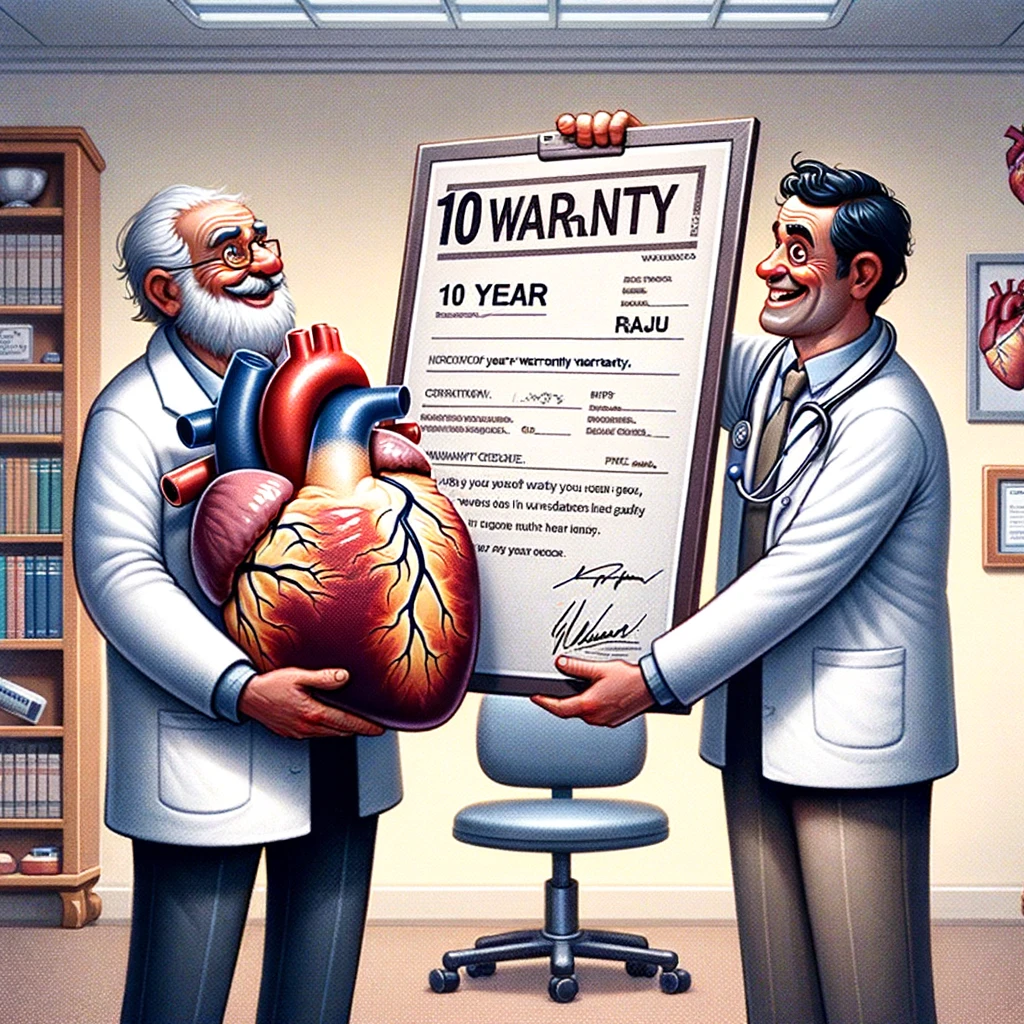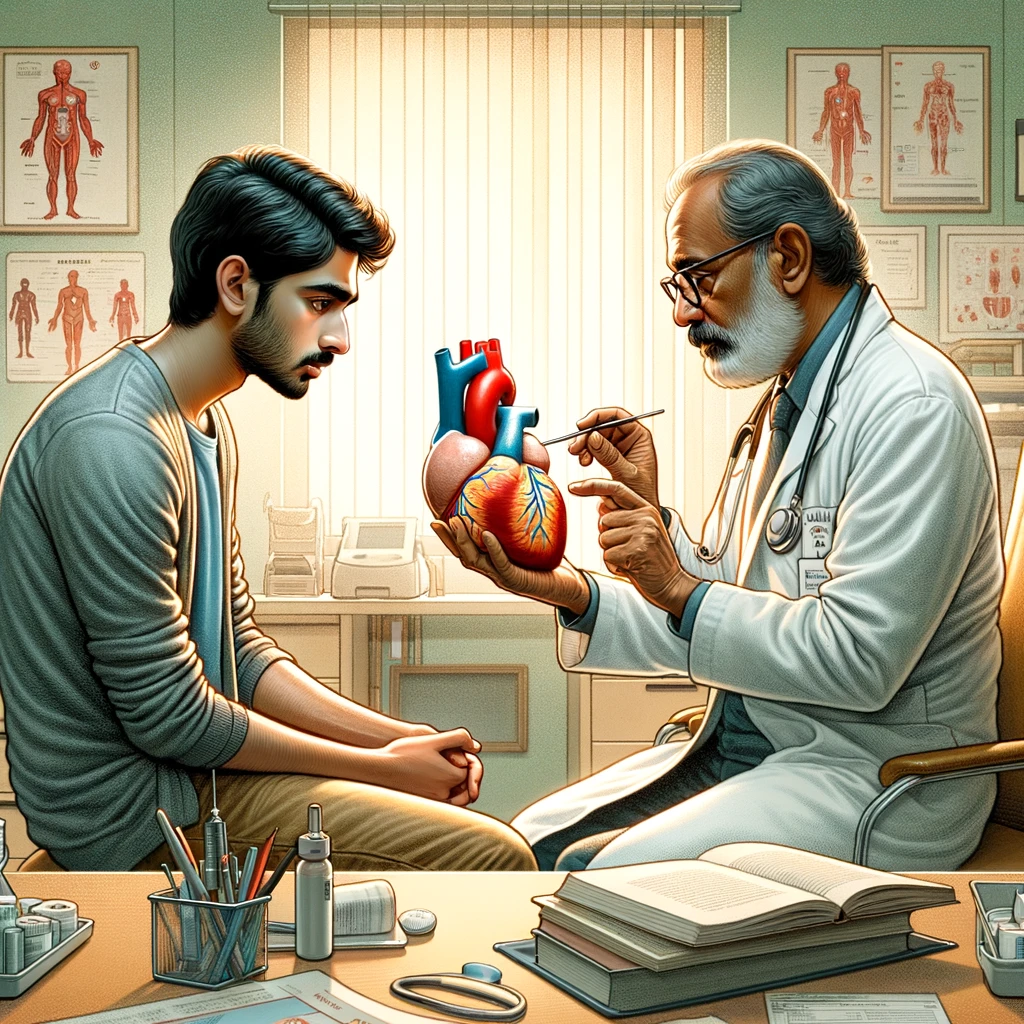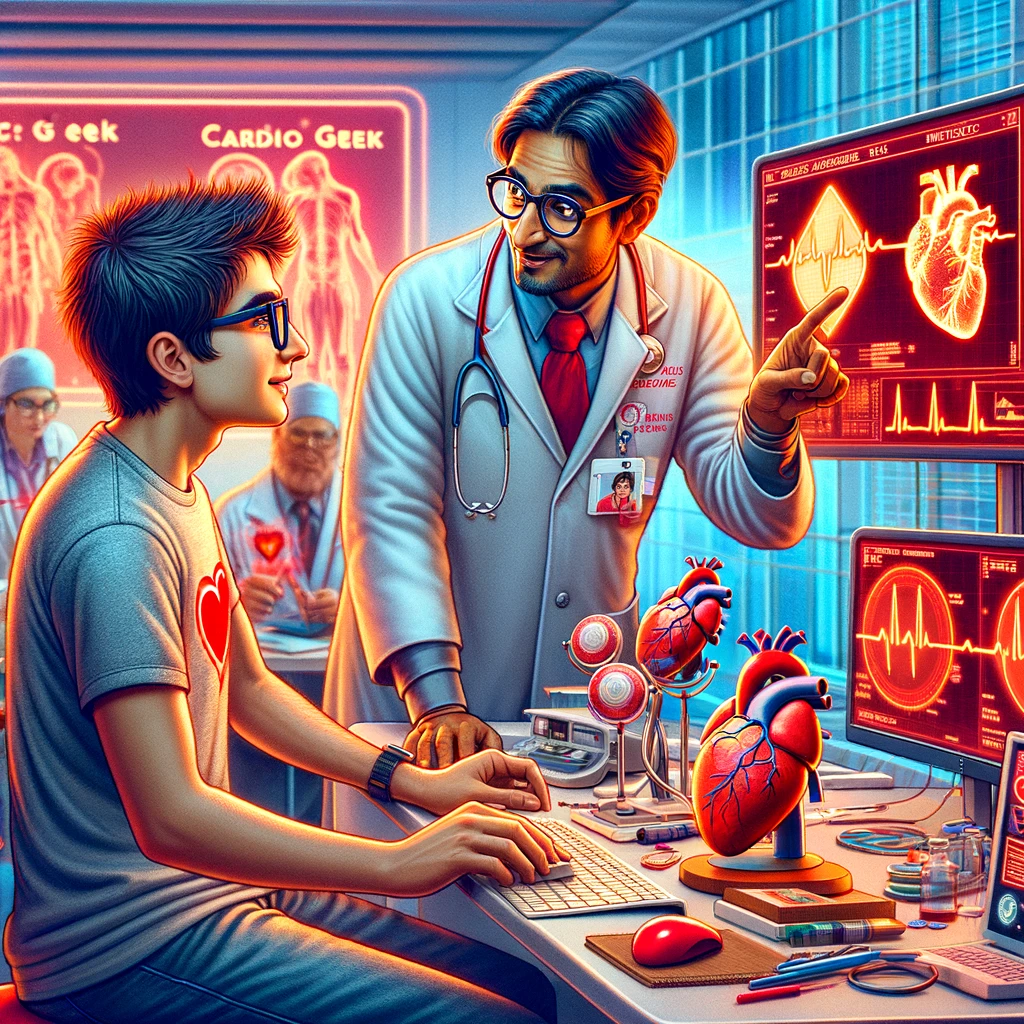Introduction: Meet Raju, the Unwitting Adventurer
Raju, at the ripe age of 54, was the quintessential IT gladiator, armed not with swords and shields but a laptop that had seen better days and an inbox always brimming with tasks. Imagine a man who smoked like he was single-handedly keeping the tobacco industry afloat, treated his hypertension and diabetes with the same casual disregard as a spam email, and wore his family’s history of heart trouble like a bizarre medal of honor at office parties. In the sprawling, caffeine-fueled empire of deadlines, deliverables, and the occasional office birthday cake (which Raju suspiciously eyed but never declined), he reigned supreme.

But like any good drama, Raju's reign in the corporate colosseum wasn't to last. Picture this: a man who had dodged more deadlines than a cat has lives, suddenly finding his invincibility challenged not by a rival company or a project gone awry, but by his own rebellious heart. It was as if his heart, tired of being ignored like the terms and conditions on a software update, decided to launch a full-blown rebellion. And so, on a day filled with the usual clacking of keyboards and the silent cries of overworked coffee machines, Raju's kingdom of complacency came crashing down.
Chapter 1: The Fall of the King
It was a day indistinguishable from any other in the grand tapestry of corporate life. The office air was thick with the scent of ambition and instant coffee, a symphony of keyboard clatter and monitor glows setting the stage. Our hero, Raju, was in his element, navigating through emails and deadlines with the skill of a seasoned captain steering through stormy seas. But little did he know, his heart had been plotting a mutiny.

With the stealth of a seasoned spy, Raju’s heart launched its surprise attack. No prior memos, no all-hands meetings, just a sudden declaration of independence that saw Raju, our indomitable IT gladiator, face down in the arena of his own making. The diagnosis came back faster than an urgent email: a heart attack, the kind of corporate sabotage that no firewall could prevent.
The news hit the office grapevine like a viral meme, spreading from cubicle to cubicle with a mix of shock and awe. “Raju? Heart attack? But he’s the guy who once chased a deadline for three days straight without sleep!” they whispered, their voices a mix of disbelief and a newfound respect for the fragility of life.

In the aftermath, the office was abuzz with more speculation than a quarterly earnings call. Terms like “PCI” and “sub-total lesion” were thrown around with the same casual misunderstanding as “synergy” and “paradigm shift.” Raju, once the king of deliverables, had been dethroned by his own rebellious organ, a turn of events more dramatic than the season finale of the office’s favorite soap opera.
As Raju was wheeled away, the kingdom he had built one spreadsheet at a time seemed to pause, a collective breath held in suspense. In the land of code and caffeine, a new legend was born, one that would be told in hushed tones over lukewarm coffee for years to come: the day Raju’s heart decided it no longer wanted to be just another cog in the corporate machine.

Chapter 2: The False Dawn
In the tech-savvy tale of Raju’s heart, the next chapter was akin to a software update that promises to fix all bugs but introduces a few new ones for good measure. The emergency PCI was pitched as the ultimate patch for Raju’s malfunctioning ticker, a sort of “Control-Alt-Delete” for the cardiovascular system. The cardiologist, sporting a confidence that could sell Halwa to Thirunelveli, extended a “10-year guarantee” on Raju’s heart, turning from a medical professional into a sort of tech support for the soul.
Raju, ever the IT warrior, couldn’t help but be impressed. In his world, warranties were like mythical promises: often spoken of but rarely upheld. Yet, here he was, walking out of the hospital with what he imagined was a newly installed antivirus in his heart, ready to fend off any future attacks with the zeal of a firewall on high alert.

Buoyed by this false sense of invincibility, Raju returned to the office with the swagger of a man who had just upgraded his internal hardware. He treated his heart like a newly optimized system, convinced that his cardiovascular software was now impervious to bugs and glitches. The complacency with which he strutted back into the corporate arena was akin to a cat who not only got the cream but hacked the dairy to ensure a lifetime supply.

In his mind, Raju was back, baby—rebooted, updated, and equipped with what he believed was the latest in cardiac defense technology. Little did he know, his heart’s operating system was about to encounter some unexpected compatibility issues, proving once again that in the world of health, as in tech, there’s no such thing as a foolproof update.
Chapter 3: The Warning Signs
Just when Raju thought he had debugged his system and was running smoothly on the latest heartware!), life decided to introduce a few unexpected pop-ups. With a sense of irony that could give Raju’s razor-sharp boss a run for his money, mild breathlessness started tailing Raju, much like a persistent software update reminder that refuses to be ignored. This new symptom was the unwanted sequel in the saga of Raju’s health, akin to releasing a buggy version of a once-loved app.
Raju, in his eternal tech optimism, initially dismissed these notifications as minor glitches, perhaps just his body’s version of adjusting to a new operating environment. However, the breathlessness proved to be more persistent than a cookie consent banner, intruding upon his daily routines and demanding attention.

Reluctantly, Raju found himself on the threshold of a preventive cardiologist’s office, a domain where terms like “functional disorder” and “ejection fraction” were tossed around with the casual familiarity of “RAM” and “processor speed” in his own world. It was as if he had been directed to the customer service department for his own physiology, seeking technical support for a body that was beginning to feel less like a well-oiled machine and more like a device struggling to meet its system requirements.

This visit marked the beginning of a deep dive into the diagnostic tools of cardiology, a field where the stakes were higher than any corrupted database or crashed server. Raju, our intrepid IT hero, was about to learn that in the complex programming of the human heart, there are no quick fixes or patches, only ongoing maintenance and the occasional critical update to keep the system running.
Chapter 4: The Reality Check
In the latest episode of our protagonist found himself sitting across from a cardiologist whose bedside manner was as comforting as an owl’s wisdom, but with the added thrill of medical jargon that could rival any IT manual. The doc, peering over his glasses with the seriousness of a system admin about to announce a network-wide outage, dropped the bombshell: heart failure. Suddenly, Raju’s heart wasn’t just underperforming; it was leaking like a poorly coded app, spewing errors and warnings all over the place.

“Think of your heart as a server,” the doc began, tapping into Raju’s tech-savvy brain, “and right now, it’s experiencing some significant downtime. Your left ventricle, in particular, is like a hard drive with bad sectors. It’s not pumping efficiently—what we call Heart Failure with reduced Ejection Fraction, or HFrEF for short.” Raju, who was more accustomed to troubleshooting software than organ failure, found this analogy both helpful and horrifying.
“And your nT-pro-BNP levels,” the cardiologist continued, unfazed by Raju’s growing alarm, “are elevated. That’s like your system sending out an SOS signal, indicating your heart is under stress. Think of it as the biological equivalent of your CPU’s temperature spiking because it’s overworked.”

Raju, desperately wishing for a Ctrl+Z function to undo this whole scenario, nodded solemnly. The terms HFrEF and nT-pro-BNP swirled in his head like cryptic error codes he couldn’t quite decipher without Google’s help. He half-expected the cardiologist to suggest turning his heart off and on again, a standard IT solution for most problems.
“But don’t worry,” the doc added, with the optimism of a software developer before a bug fix, “we’ve got treatment protocols that can help manage this. Think of it as installing updates and patches to improve functionality and security.”

As Raju left the office, he couldn’t help but think of his heart as a glitchy software program in dire need of an upgrade. The realization that his body was more than just a vessel for caffeine and stress, but a complex system requiring care and maintenance, was his biggest reality check yet. No amount of tech savvy could debug this problem; it was time to trust the experts and start the process of system optimization, one step at a time.
Chapter 5: The Battle Plan
In this next chapter, our hero was presented with a map that looked more like a traffic report from hell—triple vessel disease had turned his arterial pathways into a gridlock worse than the city’s rush hour. The cardiologist, now playing the role of a strategic commander, outlined a battle plan that sounded less like conventional medicine and more like a science fiction plot: Guidelines Directed Medical Therapy (GDMT) and Enhanced External Counter Pulsation (EECP).

GDMT, as it turned out, was not the latest government space program, but a regimented approach to heart care, involving a cocktail of medications designed to optimize heart function—essentially, the software updates and security patches for Raju’s internal operating system. And who were the directors in this off beat medical surveillance presidency? They are those clever guys sitting yonder, big names like American Heart Association (AHA) and European Society of Cardiology (ESC), waiting to spin the PKPD of each and every novel molecule into turbine of an Airbus!
Meanwhile, EECP was pitched as the heart’s personal training program, aimed at forcing new pathways to open up like emergency escape routes in a crowded building. “Think of it as rerouting traffic around the congested areas,” the cardiologist explained, “or in your world, creating new network paths to bypass a firewall.”
The goal was ambitious: to stimulate Raju’s heart into generating its own bypass routes, a concept as challenging to grasp as explaining cloud computing to someone who still thinks the internet is a series of tubes. It was akin to asking his heart to start its own construction project, laying down new pipelines and opening up blocked channels, all while continuing to pump life through Raju’s body. The doc even explained: “it’s known as natural bypass“!

Raju couldn’t help but liken the task ahead to teaching his notoriously unyielding boss the virtues of empathy—a feat so daunting that even the most skilled HR professionals would quake in their boots. Yet, armed with his new battle plan, Raju felt a spark of determination. If his heart was willing to embark on this ambitious internal infrastructure upgrade, who was he to stand in the way? After all, in the world of IT and arteries alike, sometimes the best solution is to find a clever workaround.
Chapter 6: The Turnaround
Three months into Raju’s grand reboot, after swapping cigarettes for celery sticks and elevating his medication regimen to something resembling the complexity of a space shuttle launch sequence, his heart started to behave like a software update that actually improves performance. His ejection fraction, a metric he now flaunted at parties with the same enthusiasm previously reserved for high scores in retro video games, was on the rise. The GLPS, another term he bandied about, improved so much it could have been mistaken for a software version upgrade.

Raju, the erstwhile IT warrior, had morphed into a veritable gardener of the cardiovascular variety, tending to the newly budding vessels in his heart’s terrain with the care of a meticulous coder refining lines of elegant algorithm. This gardening venture, however, involved less soil and more soul, as he cultivated pathways in his heart like a tech wizard debugging lines of code.
In this unexpected journey from tech geek to heart geek, Raju discovered the joys of cardio-landscaping, where every new vessel was a triumph of biology over pathology, a sign that lifestyle changes and medical adherence were the cheat codes to unlocking levels of health he hadn’t imagined possible. He approached his heart’s recovery with the same gusto as tackling a complex programming challenge, applying patches, updates, and the occasional reboot in the form of naps.

As Raju regaled partygoers with tales of his cardiac exploits, he couldn’t help but draw parallels between his heart’s newfound efficiency and the latest, greatest tech advancements. His heart, once a sluggish piece of legacy hardware struggling to keep pace, was now humming along like a finely tuned server, optimized and overclocked, ready to handle whatever data life decided to throw its way.
Chapter 7: The Lessons Learned
Raju’s odyssey through the corridors of cardiac care had been more enlightening than any corporate offsite loaded with trust falls and motivational speakers. He came to view smoking with the same affection one reserves for a software bug that crashes your system at 4:59 PM on a Friday—utterly detrimental and to be avoided at all costs. The control of his diabetes and hypertension was upgraded from mere background tasks to critical system processes, securing VIP status in the operating system of his health.

Annual check-ups were now marked on his calendar with the same anticipation and importance as a major software release date. These were not mere appointments but milestone events, opportunities to debug and optimize, ensuring his internal hardware was running as smoothly as a high-end gaming PC on a fiber connection.
Raju’s transformation was not just physical but philosophical. He began to see his body less like an old, reliable workstation that needed the occasional reboot and more like a sophisticated piece of technology that required regular updates, maintenance, and care. The realization dawned on him that his heart, much like his beloved gadgets, thrived on attention and fine-tuning.

He shared his insights with anyone who’d listen, drawing parallels between the health of his arteries and the stability of network systems, between heart rates and refresh rates. Raju became an evangelist for heart health, preaching the gospel of prevention with the fervor of a tech start-up founder. He learned that in the realm of health, as in technology, ignorance was not bliss but a bug to be fixed. And fix it he did, with the meticulousness of a master coder squashing bugs on a mission-critical project.
Chapter 8: The New Philosophy
Gone were the days when Raju treated his heart like an old, neglected software running in the background, assuming it would just “keep up” without any proactive maintenance. The concept of a “10-year guarantee” on his heart had been uninstalled faster than a problematic app, replaced by a robust, daily commitment to system updates in the form of GDMT and a firewall of preventive cardiology. Raju had transformed into the diligent sysadmin of his own cardiovascular system, monitoring and tweaking to ensure optimal performance.

In his newfound philosophy, Raju preached the importance of regular maintenance over relying on emergency patches. He likened his daily medications and lifestyle adjustments to running antivirus software and applying security patches—essential practices to fend off potential threats. Preventive cardiology, in Raju’s eyes, was akin to the ultimate backup system, ensuring that even if things went south, recovery was just a matter of restoring from the most recent, healthy save point.
Raju’s heart, formerly on the brink of a system crash, was now a beacon of resilience, demonstrating the power of regular check-ups and lifestyle optimizations. He became a vocal advocate in his community, likening heart health to the careful management of a complex network infrastructure. No intervention, he’d say, comes with a lifetime warranty, but with the right care and maintenance, uptime could be maximized.

He jokingly warned friends and family to avoid becoming legacy systems, vulnerable to the slightest bug. Instead, he urged them to adopt the latest health protocols, ensuring they remained compatible with a long and vibrant life. Raju’s heart had once been a ticking time bomb, but with his new operating philosophy, it was now more secure than a top-secret server, guarded not by guarantees, but by vigilant, daily care.
Epilogue: Raju’s Reflections
As Raju reflected on his epic saga from corporate gladiator to heart health hero, he marveled at the parallels between managing life and debugging code. His story, ripe for a niche podcast titled “Code Blue: Debugging the Heart,” taught him that life’s operating system requires continuous updates, rigorous patching, and the occasional hard reset.

Health, he realized, couldn’t be procrastinated on like a looming project deadline; it demanded real-time monitoring, preemptive maintenance, and an agile approach to adapt and improve. Raju’s journey underscored a universal debug log truth: the best way to avoid system failure is through relentless vigilance, timely updates, and never, ever ignoring the warning pop-ups life sends your way.